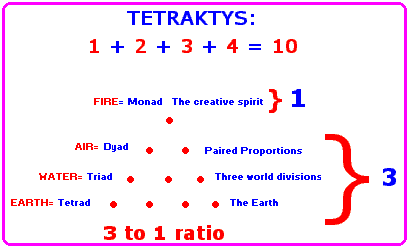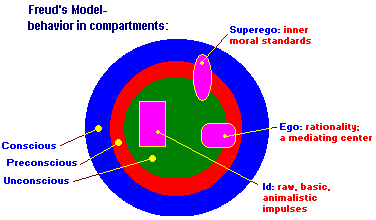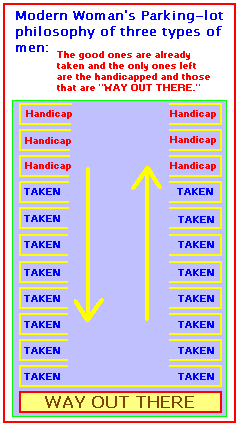 |
Threesological Examples (Three-patterned occurrences in Philosophical perspectives) Page II |
 |
(The Study of Threes)
http://threesology.org
|
3 human origin (founder) theories: Out of Africa ~ Multiregional ~ Out of Asia 3 founders of Judaism: Abraham ~ Isaac~ Jacob 3 families humankind descended from in Biblical tradition: Ham ~ Shem ~ Japheth 3 tribes that founded Rome: Tities ~ Ramnes ~ Luceres 3 founders of Poland: Lech ~ Czech ~ Rus 3 couples founded the old order Amish over 200 years ago 3 "founders" of all the horses registered in the World's Stud books: ...and these three are survived in a direct-line descendance by the three horses: http://www.imh.org/imh/bw/tbred.html The primitive man, Mannus, had 3 sons and from these sprang the three main tribes of Germany, with which may be compared the account in Genesis (9:19): "Of Noah's 3 sons was the whole earth overspread."
See also: Teutonic Peoples Harry Thurston Peck, Harpers Dictionary of Classical Antiquities (1898) 3 "founder" theories of the Universe's origin: Flat ~ Spherical ~ Saddle-shaped 3 classical "founder" Origin-of-Moon hypothesis: (1) Binary planet or "sister" hypothesis. (2) Rotational fission or "daughter" hypothesis. (3) Capture or "wife" hypothesis. 3 "founders" of the biosphere: RNA ~ DNA ~ Proteins 3 "founders" of Life: Archaea ~ Bacteria ~ Eucaryota 3 "founders" of primates: 1. Prosimians ~ 2. Monkeys (old & new world) ~ 3. Apes (lesser & greater apes, as well as humans). |
- 3 traditional syllogism forms: Categorical ~ Hypothetical ~ Disjunctive
- 3-part basic adult syllogism: All ravens are black ~ Jack is a raven ~ Therefore, Jack is black.
- 3-part basic child syllogism: Fuzzy Wuzzy was a bear ~ Fuzzy Wuzzy had no hair ~ Fuzzy Wuzzy wasn't fuzzy was he?
3 Worlds that comprise all existents & experiences as defined by Karl R. Popper:
| Karl R. Popper's 3 Worlds | ||
1. INORGANIC 2. BIOLOGY 3. ARTEFACTS Material substrates
|
Subjective Knowledge
|
Records of Intellectual efforts
|
*** The Tasady is a group of isolated people found in the Philippines (1960's) near a forest named Dafal. Few tales describe their origins. In the beginning, they say, there were 3 people who created them. These are similar to tales told by their neighbors.
***The Konyak Nagas of Assam in India believe that when a man dies his being splits into 3 spiritual entities:
- The 1st is the "soul" (yaha), to which most of the personality attaches, and which sets out on a complicated journey to the land of the Dead.
- The 2nd part remains attached to the skull and is capable of helping his surviving kinsmen in many ways. This soul-matter is called mio.
- The 3rd spiritual element, which emerges after a man meets a violent death, is called hiba, and can best be translated as "ghost."
3 aims of the great learning (attributed to Zengzi, 500 B.(.): Manifesting one's luminous virtue~ Reviewing the people~ Abiding in perfect goodness
3 levels of Xuanzang's reality (A.D. 600-664): The utterly false and erroneous~ The nominally fictitious~ The real existent
- 3 ages theory by Kong Youwei (1858-1927): Age of Disorder~ Age of Small Peace~ Age of Great Peace (Each age contains 3 rotations, that is, each age contains itself and elements of the other two.)
- 3 characteristics of being (Buddha): All constituents of being are transitory~ All constituents of being are lacking in an ego~ All constituents of "Being" are painful
- 3 gunas (strands): Sattva (goodness) ~ Rajas (passion) ~ Tamas (darkness); (In a dialogue between Krishna & Arjuna in the Bhagavad Gita)
- 3-fold yoga: Austerity (tapas)~ Study~ Dedication to a meditative ideal (Patanjali)
- Buddha spoke often of a "Middle Way" between Eternalism and Annihilationalism (continuity/discontinuity)
- 3 unconditioned dharmas (basic factors of experience & reality): Spatiality~ Disjunction from impure dharmas by deliberate awareness~ Non-arousal of impure dharmas due to the absence of their productive conditions.
- 3 nature (cognitive realms) theory: Delusional realm~ Causal dependency realm~ Perfectional realm (Yogacara texts)
- In (7th Century) Indian Philosophical circles, 3 ways of knowing (pramanas) were generally accepted: Perception~ Inference~ Testimony
- 3 manifestations of the self: Waking ~ Dreaming ~ Dreamless sleeping; beyond which is the real self (Turiya): Mandukya Upanishad
- 3 orders of existence: Absolute existence or reality ~ Empirical existence ~ Illusory existence (Shankara, A.D. 788-822)
- 3 step study of Vedantic texts with a guru: Listening to instructions ~ Understanding the teachings ~ Practicing constant meditation
- 3 steps in the quest for the knowledge of non-dual Brahman: Hearing ~ Reasoning ~ Meditating
- 3 most important (out of twenty) substances: Brahman (God) ~ Matter ~ Selves (Madhva & Ramanuja, 1017-1137).
- 3 kinds of souls: Those who are eternally free ~ Those who have attained freedom from this world ~ Those who are bound souls (Madhva, 1197-1276).
|
According to Pythagorean teaching the first four numbers (1 + 2 + 3 + 4) contained the knowledge of all things when set out in the shape of a triangle with ten dots disposed pyramidally at what is frequently described as four levels, but could also be described as a 3 to 1 arrangement, when the quantities are taken at face value: |

|
|
|
***While it is clear that a 3 to 1 ratio was not emphasized by Pythagoras or his followers in the sense of using it as a formulaic model to compare other ideas, we of the present can recognize that there does indeed exist a 3 to 1 distinction to be made amongst many of the so-called four aspects appearing in other areas of interest under varying labels.
3 means of valid knowledge confirmed by the Inner Witness: Perception~ Inference~ Testimony (Jayatirtha, 1365-1388)
3 ways of apprehending God:
- Brahman (Absolute Reality is understood non-dualistically as without qualities, powers, or sports)
- Supreme Soul (Paramatman) that creates the world and is the inner controller of nature and of souls)
- Lover of God (Bhakta) mystically apprehends God (Bhagavan) in God's own sports, qualities, and powers. (Jiva Gosvamin,1511-1596)
***Aurobindo's worldview is non-dual (advaita): In its Essence, Absolute Reality, (Brahman) is Sat (being)~ Chit(consciousness)~ Ananda (bliss, written: Saccidananda)
3 State Violence manifestations: Physical~ Ideological~ Economic destitution & starvation (Jawaharlal Nehru, 1889-1966)
3 meditative techniques of Chinul(1158-1210):
- The dual cultivation of concentration & wisdom.
- The Faith & understanding according to the Hwaom School.
- The distinctively Son (Meditation) investigation of the critical phrase, hwadu or kongan.
- 3 essential teachings of: Buddhism ~ Confucianism ~ Daoism (Taoism) are the same. (Hyujong 1520-1604)
- 3 interpretations of happiness: Purely theoretical activity~ Exclusive practical activity~ Harmonious combination of the first two: (Al-Farabi, A.D. 300-900?)
- 3 beings: Necessary~ Contingent~ Possible, classified by accidents & substances; Substance divided into 3 categories: Intellect ('aql)~ Soul (nafs)~ Body (jism); (Avicenna A.D. 350-1000?)
***AI-Ghazali (A.D.1058-1111) observed that philosophers argue that the eternity of the world follows by necessity from 3 fundamental axioms:
- Nothing comes out of nothing.
- Given a particular cause, the effect necessarily & immediately follows.
- A cause is different from & external to the effect.
He further argued that they make 3 claims as the basis for denying the belief in bodily resurrection:
- There is no logical necessity that bodies be resurrected in their physical forms.
- If there are no bodies in the hereafter, there can be neither pain nor pleasure in the other world.
- Hell & Heaven in their physical sense do not exist; they are of a purely spiritual nature.
3 groups according to degree of purity & illumination: Those who remain in the darkness of ignorance ("Ashqiya") ~ Those who purify themselves to some extent (Sudad) ~ Those who purify themselves & reach illumination (muta allihun): (Suhrawardi, A.D. 550-1150?)
3 Unities: Of the Knower~ The known~ Knowledge (Mullasadra, A.D. 1000-1600?)
...Three produces the ten thousand things.
(In classical Chinese, the "ten thousand things" means "everything." Commentators have long disagreed over what the "one, two, and three" refers to, usually plugging in their favorite Cosmological, Cosmogonic, or Metaphysical model.) Laozi further writes: Something amorphous & consummate existed before Heaven & Earth. Solitude! Vast! Standing alone, unaltering. Going everywhere, yet unthreatened. It can be considered the Mother of the World. I don't know its name, so I designate it "Dao." Compelled to consider it, name it "Great." (Dao is considered indistinct & undefinable.)
Note: It is not the vision of a visionary that helps others see more clearly, but that which they are able to articulate from memory of their visionary trek in a language you can understand. Sometimes the "language" is art, sometimes words, or sometimes in mathematical formulas...H.O.B.
The following two illustrations are adapted from chapter 1, page 9, of the book "The Lemur's Legacy" by Dr. Robert Jay Russell.
The first one describes Freud's 3-part model as a disunited compartmentalization of interior properties:

The next one describes Evolutionary Psychology's 3-part model as an active integration of interior properties:

Whether you believe in either model is beside the point that both models use a 3-part structure. The older Freudian model displays 3 separate (overlapping) functions and the newer Evolutionary Psychology model displays a 3-in-1 formulation. This same attempt at a distinction between a three-based individualized 3-part structure and a three-based 3-in-1 part structure is akin to the debates in Christian circles that revolve around whether or not the Triune Godhead is a representation of three separate individuals or 3 distinct qualities in 1 individual. In short, both arguments are representations of a particular cognitive grouping formulation. It doesn't matter whether you're discussing religion, psychology, physics, or whatever, they all, on a basic level, represent a recurring pattern-of-three in our thinking processes.
3 types of men recognized by modern women illustrated by a "Parking-lot Philosophy":
All the good ones are already taken and the only ones left are the handicapped and those that are "Way Out There."

As an historical note, I heard this "Parking-lot" reference from a woman while we were entering a building after parking our cars in an almost completely full parking lot. I had initiated the remark about having had difficulty in finding a good parking space. She made the analogy between men and parking as a two-part characterization which stated that men were like parking spaces: The good ones are already taken and the only ones left are the handicapped. I offered the third option about the ones being "Way Out There," (because we both had to park our cars some distance from the entrance); to which she eagerly and heartedly agreed with a wide-eyed appearance of someone having experienced a Eureka! moment of intellectual illumination. I had to tell her that while she was thinking of men I was applying her view to women. This brings to mind the old adage many women have applied to men:
I could never find a reference of a similar counter-part distinction specifically for women, so I developed the notion that:
I have also thus far added a third reference:
3 major relationships in the lives of people:
- One for love.
- One for money.
- One for companionship.
... (or one when you're young, one when you're established, and one to grow old with).
3 part expectation of educational [employment] systems regarding students/employess:
- Show up on time. [Show up on time].
- Study hard. [Work hard].
- Follow the rules. [Follow S.O.P's (standard operating procedures)].
3-part Philosophy of Bodwell Language School in Vancouver, Canada:
- Students deserve the best that a school can offer: a devoted, skilled and caring staff; a rich, secure and welcoming environment; and educational facilities that inspire, motivate, challenge, and help students achieve excellence in their communicative growth.
- Belief in the wave of the future - the World Wide Web and global communication.
- Help students participate in every facet of Canadian life, from the excitement of its bustling urban location in the center of Vancouver to the endless ranges of mountains that begin only minutes from downtown.
http://www.bodwell.edu/langmain2.htm
| Rigid attitudes leading to alienation from group. | Poised stance compatible with creative freedom. | Rigid attitudes leading to alienation from self. |
| Obsession | Love | Promiscuity |
| Fanaticism | Loyalty | Following |
| Role playing | Character | Anomie |
| Habit | Style | Imitation (trendiness) |
| Ideological | Open-minded | Totally receptive |
| Parochialism | Commitment/dedication | Vacillation (permanent indecision) |
| Single minded | Sense of value | Relativism |
| Observation | Participation | Submergence (being taken over) |
| Separate | Involved | Overwhelmed |
| Independent (my way) |
dialogue (our way) |
conformity (your way) |
| Þ Individual (particle) Þ / Ü Group (wave) Ü | ||
The above triad table information is from page 135 of the book "The Quantum Society" by Danah Zohar and Ian Marshall. It would seem appropriate to consider that the last wave/particle designation should be a 3-part structure: Individual (particle)/Group (wave)/Individual (particle), as an overlapping system, instead of the 2-part structure.
Triads are a well known structure of Georg Wilhelm Friedrich
Hegel's writing. A well-known formulation of the triad is
Thesis
— Antithesis — Synthesis,
or
Negation
and Negation-of-the-Negation.
The basic triad of the
Shorter Logic is Being - Essence - Notion.
Hegel would say that the Notion is the unity of Being and Essence, and that Essence is the negation of Being and Notion the truth of Essence, and that the Notion is a return to Being, but mediated rather than immediate. In history, we could say that
Primitive communism — Class society — Communism form a triad in the same way. Hegel was not the inventor of the 'triad' which was known long before. Even though Hegel is famous for the way he structured his work around triads, much of the Shorter Logic, for instance, deviates markedly from the triadic structure. Also, Hegel never mentions:
Thesis — Antithesis —
Synthesis
in his writing and every triad in his work is a
little different from every other. In reading Hegel, it is essential
to "know where you are" in the triadic structure.
http://www.marxists.org/glossary/terms/t/r.htm
3 forms of institutional turn:
- 1st. The simplest can be called the thematic turn, i.e., the intuition, hypothesis, or discovery that various institutional aspects of social life should be included among the key themes of social enquiry.
- 2nd. The methodological turn, ie., the intuition, hypothesis, or discovery that the institutional aspects of social life provide a fruitful – or even, indeed, the most productive – entry point for exploring and explaining the social world even if the ensuing research is extended later to include other themes or explanatory factors.
- 3rd. The ontological turn, i.e., the intuition, hypothesis, or discovery that institutions constitute the essential foundations of social existence.
© Bob Jessop, Institutional (Re)Turns and the Strategic-Relational Approach', published by the Department of Sociology, Lancaster University at:
http://www.comp.lancs.ac.uk/sociology/soc046rj.html
3 forms of philosophical analogy with a bent towards the sociological and psychological:
3 blind men and an elephant- various versions of... 7,6,5,4, & 3 blind men occur. 3 links provided:
http://www.wordfocus.com/word-act-blindmen.html
--- Elephant in the Dark...paragraph ---
http://perkunas.vtu.lt/Psichologija/Elephant.html
--- The blind men and the elephant ---
http://www.cs.princeton.edu/~rywang/berkeley/258/parable.html
Plato and his cave- One link provided:
http://lilt.ilstu.edu/jhreid/plato_and_cave.htm
Idols of the Mind by Sir Francis Bacon- One link provided:
http://www.mv.com/ipusers/oleary/cave/idols.html
3 Perspectives on the Phenomenon of Control- (Three Blind Men and the Elephant) by Richard S. Marken:
http://home.earthlink.net/~rmarken/blind.html
3 to 1 ratio of Jean Piaget's stages of cognitive development:
- 1 of 1.
Sensorimotor (birth to 2 years)
- The mental structures are mainly concerned with the mastery of concrete objects. - 1 of 3.
Preoperational (2 years to 7 years) - The mastery of symbols takes place.
- 2 of 3.
Concrete operational (7 years to 11 years) - Children learn mastery of classes, relations, and numbers and how to reason.
- 3 of 3.
Formal operational (abstract thinking) (11 years and up) - The last stage deals with the mastery of thought.
http://www.nwlink.com/~donclark/hrd/history/piaget.html
3 systems interaction theory of artistic development by Howard Gardner (he developed the Multiple Intelligences theory):
- "Making" – producing acts or actions, e.g., as by a composer or performer.
- "Perceiving" – producing discriminations or distinctions, e.g., as the critic.
- "Feeling" – producing affects, e.g., as in members of the audience.
http://www.home.duq.edu/~bowmanj/mupsych/pages/gardner.html
3 modes of cognitive processing to represent knowledge, by Jerome Bruner (he developed the "spiral curriculum" theory):
- Enactive Mode - in which children represent their environment through action or demonstration.
- Iconic Mode - in which children represent their environment through visual or other sensory images.
- Symbolic Mode - in which children represent their environment through words or language.
http://www.home.duq.edu/~bowmanj/mupsych/pages/bruner.html
Date of Origination: (approx.)Sunday, 31st December 2000... 11:18 PM
Posted Update: Thursday, 24th May 2018, 5:48 AM
Herb O. Buckland
herbobuckland@hotmail.com
